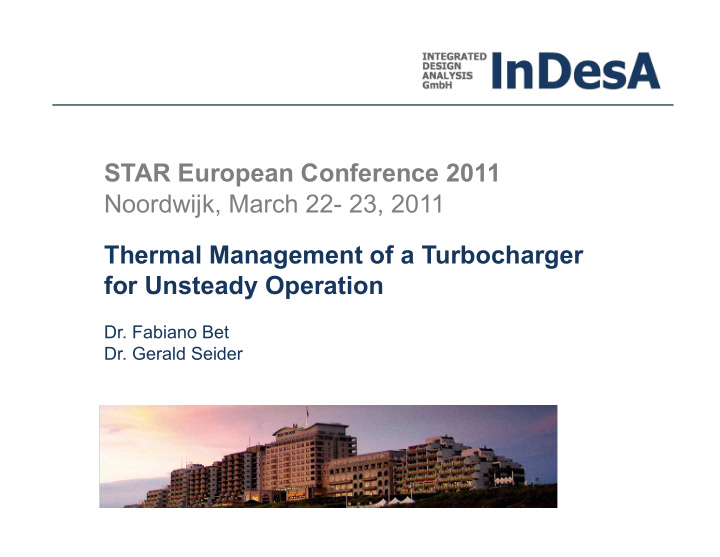



STAR European Conference 2011 Noordwijk, March 22- 23, 2011 Thermal Management of a Turbocharger for Unsteady Operation Dr. Fabiano Bet Dr. Gerald Seider
Company Profile Consulting- & Engineering Services Simulation and Analysis of complex fluid flow and heat transfer systems for engineering and industrial applications 3D CFD/CHT Analysis • Vehicle Thermal Management • Engine Thermal Management • Electronics & Battery Thermal Management • Heat Exchanger Thermal Analysis 1D System Analysis • Turbomachinery Flow and Thermal Analysis and more … GT-SUITE InDesA GmbH Anton-Ditt-Bogen 27 D-80939 München Phone +49 (89) 552 7978-10 Fax +49 (89) 552 7978-29 www.InDesA.de
Turbocharger Thermal Management of a Turbocharger InDesA GmbH 18.03.2010 page 3 Motivation Complete flow and thermal analysis of a turbocharger: Compressor flow Compressor flow Turbine flow Turbine flow Coolant flow Coolant flow Oil flow Oil flow Structure heat fluxes Structure heat fluxes Radiation to environment Radiation to environment Flow driven rotating assembly Flow driven rotating assembly
Turbocharger Thermal Management of a Turbocharger InDesA GmbH 18.03.2010 page 4 Motivation Motivation: Thermal reliability of materials → Materials selection, durability, costs Radiation trough turbocharger surface → Thermal damaging of adjacent parts; → Heat shields Oil coking in the slide bearing → Oil damaging, bearing damaging; → Cooling concepts Compression- and Flow loss in the compressor → temperature increase in charging air; → dimensioning intercooler → Influencing local speed of sound and Mach number → Influencing acoustic transmission → Influencing the compressor filling limits.
Turbocharger Thermal Management of a Turbocharger InDesA GmbH 18.03.2010 page 5 Heat Fluxes on Turbocharger Compressor Housing Water Jacket Turbine Housing · Q Air · · Q Convective Q Exhoust Gas · Q Radiation · Turbine Q Cool. Compressor · Q Oil · · Q Air Q Exhoust Diffusor Journal Bearing Labyrinth Seal · Q Oil Oil Chamber · Q Cool.
Turbocharger Thermal Management of a Turbocharger InDesA GmbH 18.03.2010 page 6 Model Description Exhaust Manifold Exhaust Manifold Coupled with Compressor Outflow Compressor Outflow: Time Dependent Pressure Outlet Compressor Housing Heat Shield Turbine Outflow: Compressor Inflow: Turbine Housing Mesh: 14 · 10 6 Volume Cells Pressure Outlet Stagnation Pressure and Polyhedral with 4 Prism Layers Temperature Oil; Coolant: 24 Regions Inflow: Mass flow and Temperature 7 Physics Continua Outflow: Pressure Outlet - Air Compressible, Ideal Gas - Exhaust Gas Compressible, Ideal Gas - Coolant Temp. dependent property - Oil Temp. dependent property - Steel Temp. dependent property - Alloy Temp. dependent property - Brass Temp. dependent property
Turbocharger Thermal Management of a Turbocharger InDesA GmbH 18.03.2010 page 7 Mesh details
Turbocharger Thermal Management of a Turbocharger InDesA GmbH 18.03.2010 page 8 Methodology 1D GT-Power Engine Model Delivers Time Dependent: Intake Pressure Exhaust Mass Flow Exhaust Temperature Intake Pressure Exhaust Temperature Exhaust Mass Flow 3D StarCCM+ turbocharger Model: Predicts Time Dependent: Air Mass Flow Turbine Rotating Rate Environment Temperature Distribution on Manifold and Turbocharger Thermal Stress Environment
Turbocharger Thermal Management of a Turbocharger InDesA GmbH 18.03.2010 page 9 Fluid-Structure Coupling Mass Flow in Exhaust Manifold: Time Dependent Turbocharger Rotating Rate: Time Dependent Where: = Angular Acceleration J = Momentum of Inertia
Turbocharger Thermal Management of a Turbocharger InDesA GmbH 18.03.2010 page 10 Boundary Conditions Cyl. #1 Cyl. #2 Cyl. #3 Firing Order: 1; 5; 4; 8; 2; 3; 6; 7 (assumed) Cyl. #4 From Steady State Solution, the fuel mass flow is Temperature (°C) assumed to increase linearly: Fuel Mass Flow Mass Flow (Kg/s) Time Time
Turbocharger Thermal Management of a Turbocharger InDesA GmbH 18.03.2010 page 11 Dynamic Result: Acceleration of TC Turbine Torque Compressor Torque Resultant Torque Torque (N/m) Angular Acceleration (rad/s ² ) Rotation Rate (rad/s) Angular Acceleration Rotating Rate Time (s)
Turbocharger Thermal Management of a Turbocharger InDesA GmbH 18.03.2010 page 12 Dynamic Result: Acceleration of TC Heat Shields: Incident Radiation: = 862 W Average Temperature = 136 °C Solid temperature distribution
Turbocharger Thermal Management of a Turbocharger InDesA GmbH 18.03.2010 page 13 Dynamic Result: Acceleration of TC Gas and Air Temperature @ steady condition: Gas and Air Temperature after acceleration: Rotation Rate = 21500 rpm Rotation Rate = 107370 rpm Average Exhaust Gas Temp. = 672 °C Average Exhaust Gas Temp. = 549 °C Average Exhaust Mass Flow = 0,02315 Kg/s Average Exhaust Mass Flow = 0,1448 Kg/s Time
Turbocharger Thermal Management of a Turbocharger InDesA GmbH 18.03.2010 page 14 Dynamic Result: Acceleration of TC
Turbocharger Thermal Management of a Turbocharger InDesA GmbH 18.03.2010 page 15 Dynamic Result: Acceleration of TC Exhaust-Outlet mass flow Air mass flow Fuel mass Flow Exhaust mass flow Mass Flow (Kg/s) Mass Flow (Kg/s) Time (s)
Turbocharger Thermal Management of a Turbocharger InDesA GmbH 18.03.2010 page 16 Dynamic Result: Acceleration of TC Power (W) Compressor Power Turbine Power Time (s)
Turbocharger Thermal Management of a Turbocharger InDesA GmbH 18.03.2010 page 17 Dynamic Result: Acceleration of TC Environment 23 W 194 W 9 W 775 W 907 W Coolant: 7 W +907 W Housing 117 W Compress Turbine- or- housing 17 W 22 W housing 5 W Wastegate Bearing 56 W Compres Turbine sor 35 W Oil: +91 W 7 W (Trough shaft) 974 W 297 W 94 W 7 W 2 W 20 W Air: +2920 W Exhaust: -4112 W 2819 W (Mech. Power)
Thank You For attention Turbocharger: Thermal analysis InDesA GmbH Anton-Ditt-Bogen 27 D-80939 München Phone +49 (89) 552 7978-0 Fax +49 (89) 552 7978-29 www.InDesA.de
Recommend
More recommend